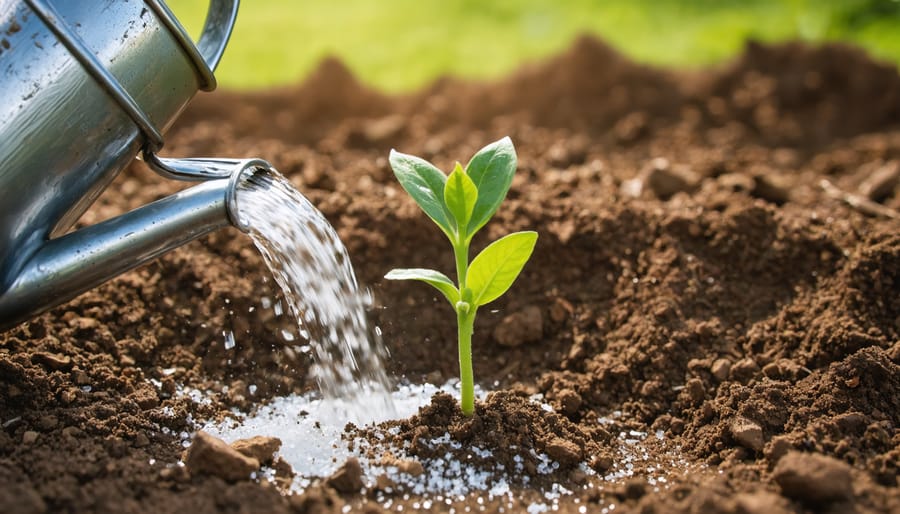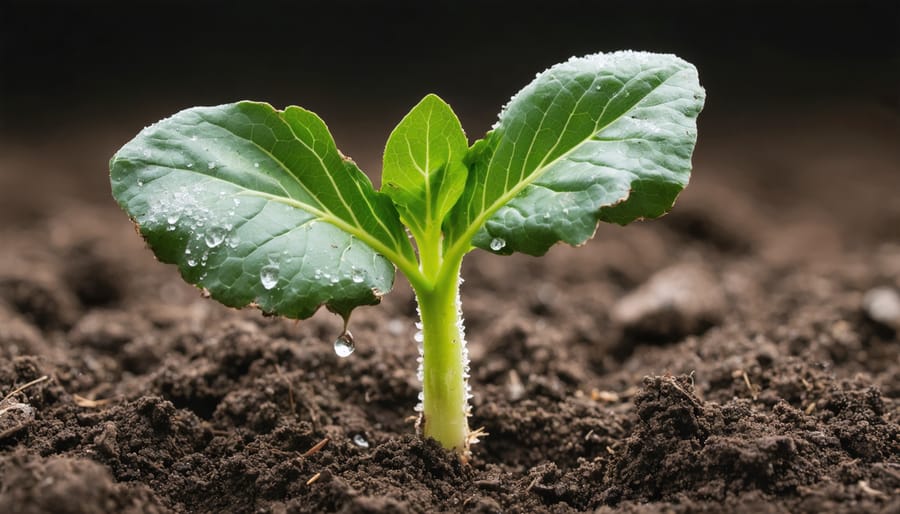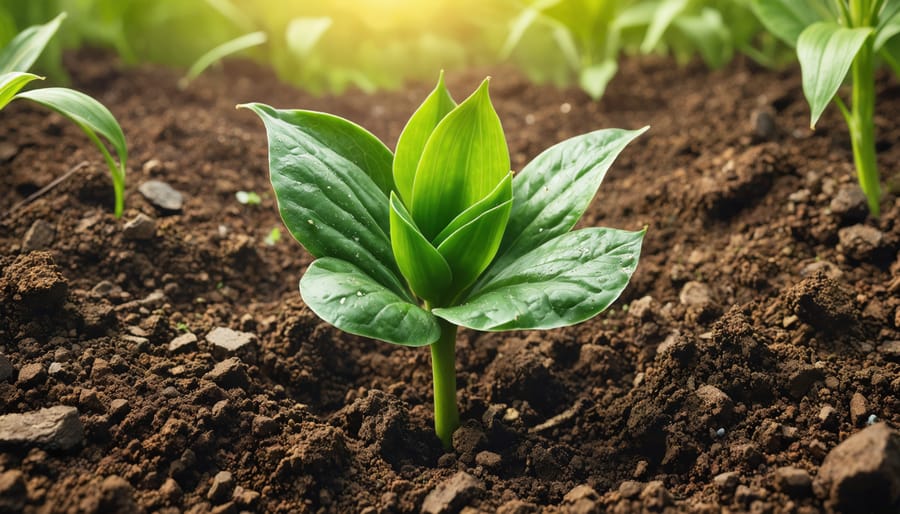As our gardens face increasingly unpredictable weather patterns, smart plant selection and adaptive growing techniques have become essential for successful gardening. Climate change brings new challenges – from extended droughts and intense heat waves to unseasonable frosts and erratic rainfall – but it also opens doors to exciting possibilities in our gardens.
Today’s gardeners are pioneering creative solutions, growing plants that once seemed impossible in their regions while protecting beloved traditional varieties. By understanding how climate change affects our local growing conditions, we can make informed choices that transform our gardens into resilient ecosystems ready to thrive in changing times.
Whether you’re a seasoned gardener or just starting out, adapting to climate change doesn’t mean giving up your favorite plants. Instead, it’s about working with nature’s new rhythms, embracing water-wise practices, and selecting varieties that can handle weather extremes. In this guide, we’ll explore practical strategies to climate-proof your garden while maintaining its beauty and productivity for years to come.
Let’s discover how to create a garden that not only survives but flourishes in our changing climate, using simple, effective techniques that work with nature rather than against it.
The New Normal: Understanding Climate Volatility in Your Garden
What Your Plants Are Telling You
Your garden plants are like nature’s early warning system, sending clear signals about our changing climate. Experienced gardeners are noticing their perennials blooming weeks earlier than usual, while heat-sensitive plants like lettuce and spinach bolt faster than in previous years. These changes aren’t just minor inconveniences – they’re your plants communicating important shifts in their growing environment.
Watch for telltale signs of climate stress: leaves curling or showing brown edges during unexpected heat waves, sudden wilting despite regular watering, and unusual pest problems as insects emerge earlier in the season. Many gardeners report their plants experiencing “false springs,” where early warm spells trigger premature blooming, leaving plants vulnerable to late frosts.
Zone-hardy plants that once thrived may now struggle, while warm-weather varieties are extending their growing range northward. Fruit trees might flower too early or produce irregular harvests due to disrupted chill hours. Even reliable bloomers like daylilies and black-eyed Susans might show altered flowering patterns, blooming at unexpected times or for shorter durations.
Understanding these signals helps you adapt your gardening practices and choose more resilient plants for your changing local climate.
Your Growing Zone Isn’t What It Used to Be
If you’ve been gardening for a while, you might have noticed that plants that once thrived in your garden are now struggling, or that you can suddenly grow varieties that previously couldn’t survive your winters. This isn’t your imagination – it’s a direct result of shifting hardiness zones due to climate change.
Many gardeners are discovering that their traditional growing zones have moved northward by half a zone or more in recent decades. What does this mean for your garden? Plants that were once perfectly suited to your area might now face heat stress during summer, while new possibilities open up for growing warmth-loving varieties that previously couldn’t survive in your region.
This change affects everything from when to plant your vegetables to which perennials will survive long-term in your garden. While it might be exciting to experiment with new plants that were once too tender for your area, it’s important to remember that these zones continue to shift. The key is to stay flexible in your plant choices and keep an eye on local weather patterns rather than relying solely on older zone maps.

Smart Strategies for Unpredictable Weather
Weather-Proofing Your Garden
As weather patterns become increasingly unpredictable, protecting your garden requires a combination of permanent structures and flexible solutions. Installing sturdy trellises and pergolas creates windbreaks while offering support for climbing plants. These structures can be enhanced with removable shade cloth or frost protection fabric, allowing you to adjust coverage based on seasonal needs.
Consider investing in cold frames or mini-greenhouses, which act as protective bubbles for sensitive plants during extreme weather events. These structures can be opened during mild weather and sealed tight when temperatures drop or storms approach. For smaller gardens, portable row covers and cloches provide excellent protection for individual plants or rows of vegetables.
Water management is crucial in weather-proofing your garden. Install raised beds with good drainage systems to prevent waterlogging during heavy rains. Adding mulch around plants helps retain moisture during dry spells while protecting roots from temperature fluctuations. Consider installing a rain garden in low-lying areas to manage excess water and prevent flooding in other parts of your garden.
For container gardens, use wheeled platforms or dollies to move plants quickly when extreme weather threatens. Group containers together during cold snaps – this creates a microclimate that helps protect all plants. Keep emergency supplies like frost blankets, stakes, and temporary shelters readily available, and develop a quick-response plan for sudden weather changes.

Flexible Planting Schedules
Gone are the days when we could rely solely on traditional planting calendars. With shifting weather patterns and unpredictable seasons, successful gardening now requires a more flexible approach to planning and planting schedules.
Start by keeping a garden journal to track local weather patterns and frost dates over several years. This personal record will help you identify trends specific to your microclimate and adjust your planting schedule accordingly. Consider breaking away from single, large plantings and instead opt for smaller, staggered plantings every two to three weeks.
Succession planting has become more crucial than ever. Rather than putting all your eggs in one basket, plant multiple varieties of the same crop with different maturity dates. If an unexpected frost or heat wave affects one planting, others may survive. For example, plant both early and late varieties of tomatoes, or quick-maturing and slower-growing lettuce varieties.
Create a “buffer zone” in your planting schedule by starting some seeds indoors earlier than usual, while keeping others in reserve. This strategy allows you to replace damaged plants quickly or take advantage of unexpectedly favorable conditions.
Consider using season extenders like row covers, cold frames, or hoop houses. These tools give you the flexibility to protect plants from unexpected weather events and extend your growing season at both ends, making the most of whatever Mother Nature throws your way.
Remember to remain adaptable and don’t be afraid to experiment with new planting times. What worked last year might not work this year, and that’s okay – it’s all part of gardening in a changing climate.
Water-Wise Garden Design
Creating a water-wise garden is becoming essential as climate patterns become more unpredictable. The key to success lies in managing both drought and excess rainfall through thoughtful design choices that work with nature, not against it.
Start by analyzing your garden’s natural water flow and soil conditions. Create gentle slopes and swales to direct water where it’s needed most, and incorporate rain gardens in low-lying areas to capture excess water during heavy storms. These features not only prevent flooding but also help store moisture for drier periods.
Choose permeable materials for pathways and gathering spaces to allow water to seep naturally into the ground. Gravel, permeable pavers, or wood chips are excellent options that add both functionality and visual appeal to your garden.
Group plants with similar water needs together, a technique called hydrozoning. This smart approach ensures efficient water use and helps plants thrive in their ideal conditions. Consider creating moisture zones, with drought-tolerant plants in well-drained areas and moisture-loving varieties in spots that naturally collect water.
Add organic matter to your soil regularly to improve its water-holding capacity. Mulch generously around plants using materials like wood chips or straw to reduce evaporation and maintain consistent soil moisture. Remember to leave some space around plant stems to prevent rot and encourage healthy growth.
Installing a rain barrel or two can help capture valuable rainwater for use during dry spells, making your garden more resilient and sustainable.
Climate-Resilient Plant Selection
Tough Plants for Tough Times
As gardeners face increasingly unpredictable weather patterns, choosing plants that thrive in variable conditions has become essential for maintaining a resilient garden. Fortunately, nature has equipped many plant species with remarkable adaptability to weather extremes.
Sedums and succulents top the list of climate-resilient plants, thanks to their water-storing capabilities and tolerance for both heat and cold. Try Autumn Joy sedum or hens-and-chicks for foolproof options that add year-round interest to your garden.
Lavender and Russian sage shine in challenging conditions, producing beautiful blooms while tolerating both drought and temperature swings. Their silver-gray foliage actually helps reflect sunlight and conserve moisture, making them perfect for hot, dry spots.
Native plants deserve special attention because they’ve already adapted to your local climate over thousands of years. Black-eyed Susans, coneflowers, and butterfly weed not only weather tough conditions but also support local pollinators.
For edible gardens, consider heat-loving Mediterranean herbs like oregano, thyme, and rosemary. These culinary favorites actually develop more intense flavors when grown in challenging conditions. Bush beans and cherry tomatoes are excellent choices for variable weather, as they can produce well even when conditions aren’t perfect.
Don’t forget ornamental grasses like switchgrass and fountain grass. Their deep root systems help them survive both drought and flooding, while their graceful movement adds dynamic beauty to any garden space.
Remember, these tough plants might take a season to establish, but once settled, they’ll reward you with reliable performance year after year, regardless of what Mother Nature throws their way.
Creating Plant Communities
Creating resilient plant communities in your garden is like building a supportive neighborhood where each member helps the others thrive. By grouping plants that naturally complement each other, you can create micro-ecosystems that better withstand climate challenges while reducing maintenance needs.
Start by selecting plants with varying root depths. Deep-rooted plants like yarrow or echinacea can access water and nutrients from lower soil layers, while shallow-rooted companions like thyme or sedum maximize resources near the surface. This layered approach helps prevent soil erosion and improves water retention throughout your garden bed.
Consider incorporating nitrogen-fixing plants such as clover or beans alongside heavy feeders like tomatoes or squash. These helpful neighbors naturally enrich the soil, reducing the need for additional fertilizers. Tall plants can provide shade and wind protection for more delicate species, while ground covers help retain soil moisture and suppress weeds.
Native plant combinations are particularly effective as they’ve already adapted to local conditions over thousands of years. For example, pairing native grasses with flowering perennials creates natural habitats that support local wildlife while being inherently more resilient to weather extremes.
Remember to group plants with similar water needs together. This practice, known as hydrozoning, ensures efficient water use and prevents both over- and under-watering. Consider creating clusters of drought-tolerant plants in areas that receive full sun, while keeping moisture-loving varieties together in shadier spots.
As these plant communities establish themselves, you’ll notice they become increasingly self-sustaining, requiring less intervention while better adapting to our changing climate.

Your Garden’s Future
Monitoring and Adapting
Successful gardening in a changing climate requires vigilant monitoring and a willingness to adapt. Start by keeping a detailed garden journal to track planting dates, weather patterns, and plant performance throughout the seasons. Note unusual weather events, flowering times, and how different plants respond to temperature fluctuations.
Digital tools can enhance your monitoring efforts. Weather stations, soil moisture meters, and temperature sensors provide valuable data to inform your gardening decisions. Many gardeners find smartphone apps helpful for recording observations and receiving local weather alerts.
Watch for signs that plants are struggling, such as leaf scorch, unusual flowering patterns, or poor fruit production. These indicators can help you identify which plants might need different care or replacement with more resilient varieties.
Be prepared to adjust your gardening practices based on your observations. This might mean changing watering schedules, adding shade cloth during heat waves, or relocating plants to more suitable spots in your garden. Remember that successful adaptation is an ongoing process – what works one season might need adjustment in the next.
Regular soil testing becomes even more crucial as climate patterns shift, helping you maintain optimal growing conditions for your plants.
Building Garden Resilience
Building a resilient garden starts with creating a climate-adaptive garden that can withstand varying weather patterns. Start by improving your soil’s structure with organic matter, which helps retain moisture during dry spells and provides better drainage during heavy rains. Consider installing windbreaks using sturdy shrubs or trees to protect delicate plants from increasingly strong storms.
Diversity is your garden’s best friend – plant different species with varying climate tolerances to ensure that if some plants struggle, others will thrive. Choose native plants when possible, as they’re naturally adapted to your local conditions and provide essential habitat for beneficial insects and wildlife.
Implement water-wise strategies like mulching and installing efficient irrigation systems. Group plants with similar water needs together, and create micro-climates using features like raised beds and shade structures. Consider adding rain gardens or swales to manage excess water during intense storms.
Remember to observe and document your garden’s response to weather changes. This knowledge will help you make informed decisions about plant selection and placement in the future, making your garden more resilient with each passing season.
While climate change presents significant challenges for gardeners, there’s plenty of reason for hope. By adapting our gardening practices, we can create resilient gardens that thrive in changing conditions while contributing to climate solutions. Start small by incorporating drought-resistant plants, implementing water-saving techniques, and adding more native species to your garden. Consider creating a rain garden or installing a rainwater collection system. Remember, every positive change in your garden matters – whether it’s reducing chemical fertilizers, composting kitchen waste, or planting an extra tree. Together, we can cultivate gardens that not only survive but flourish in our changing climate while helping protect our planet’s future. Your garden can be part of the solution, and the time to start is now. Join your local gardening community, share your experiences, and keep learning as we adapt to these new challenges together.




